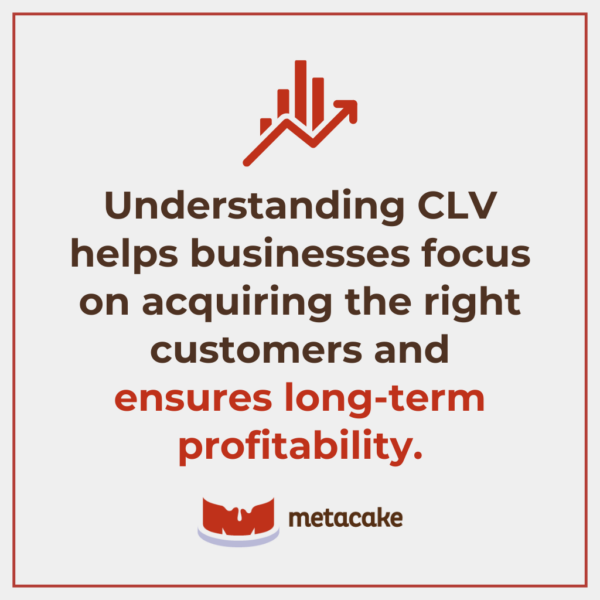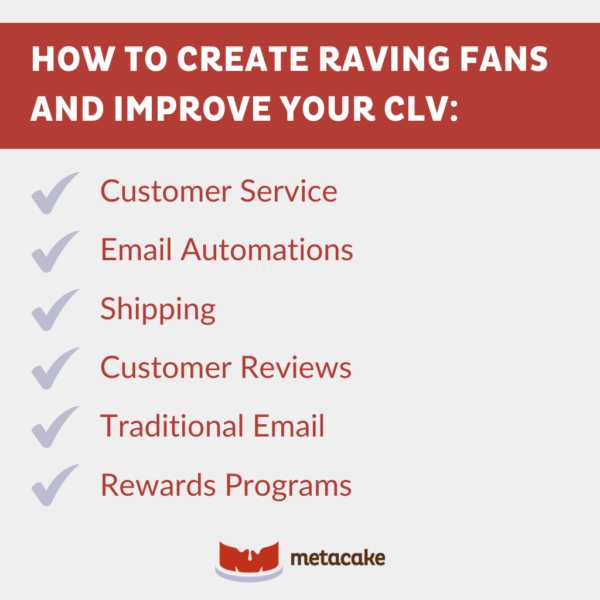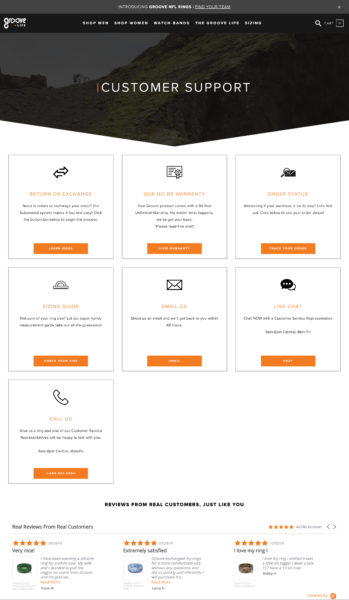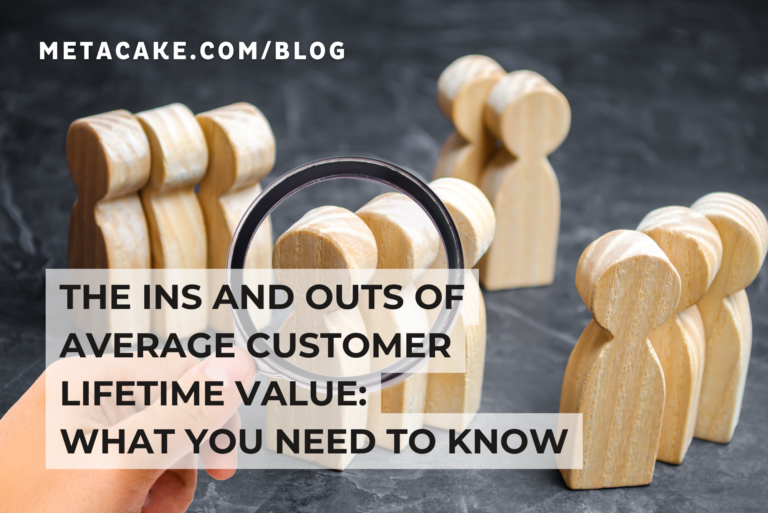How do you measure the success of your ecommerce business? Do you generally focus on things like sales and revenue?
While these metrics are useful for assessing the short-term performance of content and initiatives, they don’t necessarily provide a clear picture of the financial future of your business. Even looking at your current sales figures can only provide you with a hazy picture of your genuine financial status.
Understanding customer lifetime value (CLV) helps businesses focus on acquiring the right customers and ensures long-term profitability.
In this article, we’ll go over how to calculate your average customer lifetime value, what a healthy scale looks like in terms of CLV, and some strategies you can use to improve your CLV.
How to Calculate Average Customer Lifetime Value
Customer lifetime value is a crucial metric for businesses, especially in the realm of ecommerce. It represents the total revenue a business can reasonably expect from a single customer account throughout their entire relationship with the company. Here’s how it’s calculated:
- Average Order Value (AOV): This is the average amount a customer spends per order. It’s calculated by dividing the total revenue by the number of orders. For instance, if a customer typically spends $150 per order, that’s the AOV.
- Purchase Frequency: This refers to how often a customer makes a purchase. If a customer buys twice a year, the purchase frequency is 2/year.
- Customer Lifespan: This is the duration of the customer’s relationship with the business. If, on average, a customer stays with the business for three years, that’s the customer lifespan.
Now, let’s put it all together:
CLV = AOV × Purchase Frequency × Customer Lifespan
For example:
- AOV = $150
- Purchase Frequency = 2/year
- Customer Lifespan = 3 years
The CLV would be:
CLV = $150 × 2/year × 3 years = $900
Optimizing CLV involves strategies like personalized marketing, excellent customer service, and rewards programs. Remember, a healthy Lifetime Value to Customer Acquisition Cost (LTV: CAC) ratio is about 3:1, indicating sustainable growth.
Understanding CLV helps businesses focus on acquiring the right customers and ensures long-term profitability.

What Does a “Healthy” Scale Look Like?
“Scale” — it’s the thing all entrepreneurs, owners, investors, and executives want for their businesses. The problem is that most businesses don’t realize what it takes to scale and why they want it. Scale can actually be the worst thing for your business (and your life!). If done incorrectly, scale will inflict massive pain and put you out of business.
Scale is only good if it’s healthy and profitable. If you think this is easily accomplished by just adding more customers, you’re seriously incorrect. A healthy and profitable scale only comes from optimizing your business with systems, processes, and automations that help create happy customers.
There are many areas of business that can be scaled. However, the one we’ll focus on today creates the most impact when it comes to creating a truly successful ecommerce business. And that’s customer lifetime value.
When we talk about healthy scale, we’re planning for long-term, sustainable growth. And the best way to do that is by growing customer lifetime value — or, in other words, by creating raving fans.
Fan creation is at the center of our strategy for how we scale brands from zero to over eight figures in under three years. It simply works, but you have to approach it the right way.
How to Improve Your CLV Today
We’re going to give you six high-impact areas to focus on to improve your CLV and create raving fans, specifically using automations and systems.
Just like a crazy sports fan who’ll do anything for his team, we want customers to shout about your brand from the hills.
And just like the die-hard Apple fanboys out there (you know who you are), we want to cultivate fans who believe in your product so much that they’ll fight for it against competitors all day long.
These fans are an asset to your business because they’re your brand evangelists. The fact is, the world will listen to them more than they’ll listen to you.
This fanbase takes time and effort to develop, but today’s concept of automation will help make this process a little more simple. Let’s dive into six ways to use automation to create raving fans while you sleep.

6 Ways to Create Raving Fans and Improve Your CLV
1. Customer Service
Your customer service team is the front line of fan creation. It’s a pivotal point for the customer experience because it can turn a customer’s frustrations into either surprise and delight or disappointment.
These days, customers expect to be disappointed, so when you can shift that anxious energy into gratitude, that’s a powerful thing!
While customer service is a personal aspect of business, there are tools that can help make it more efficient and effective. For example, we recommend using chat scripting to help assist customers at the beginning of the conversation. The customer can then be transferred to a real human as needed. This allows customers to self-solve many issues rather than bombarding your support team with every need.
Another way to automate customer service and help customers self-solve their concerns is to build a great customer service page on your store. This can include FAQs, links to helpful articles, product recommendations, sizing information, warranty links, and return links.
To avoid frustration, be sure to provide an easy way to get in touch with someone on your team if they need it. Groove Life has a great example of a page that does this well:

Customer service tools we recommend:
- Zendesk: Integrates all channels, making it easy for your staff to stay organized.
- Intercom: Merges chat and email, allowing chat scripting to offload work and mundane tasks.
- Gorgias: Does all of the above but uses intelligent automation with responses to common questions (such as “Where is my package?”).
- SaveMySales: A human-aided outsourced extension to your team to not only do customer service but actually assist the customer in the process of buying your product.
2. Email Automations
We all know the power of email. Time and time again, email has proven to be the channel with the highest ROI. Plus, as a channel you actually own, it’s one of the most stable assets you’ll ever use.
Many brands use email to sell their products. But if you’re not using it to build and maintain relationships with your customers, you’re not using the channel to its fullest potential. After all, these relationships will turn into — you guessed it — brand fans.
Implementing automated email sequences tailored to what you know about each customer and their behaviors on your site is a key way to nurture these relationships.
The Must-Have Automations
If you’re not familiar with how email automations work, you can check out our quick guide to automated email campaigns. As a refresher, the basic sequences every customer should have running at all times include:
- Abandon cart: Follow up with site visitors who’ve abandoned checkout, encouraging them to make a purchase by sweetening the deal. Take a look at best practices for abandoned cart sequences here.
- Post-purchase: Thank your customer for purchasing and prepare them for what to expect with shipping and tracking. Educate them about the best way to use their purchase.
- Pre-purchase: Welcome your new subscriber with an email series customized to their interests, based on gender and products of interest. This series will drip content that shares your brand story and what you have to offer.
In these flows, your message should not be constantly pushing sales. We recommend a ratio of 2:1, meaning two emails that provide valuable information for every one email that sells.
Tools for Automated Emails
- NOT Mailchimp: This is often the go-to for email campaigns because it’s cheap and easy to get started. However, it fails miserably for ecommerce and for sending automated sequences.
- Klaviyo: This is our top recommendation for creating scalable email campaigns and sequences that deliver value and create real revenue. Once integrated with your ecommerce store, all your store data flows into the platform. As a result, you can create highly targeted segments and run intelligent campaigns.
- Drip (and others): This is similar to Klaviyo in the data they use, but the platform isn’t as mature, robust, or effective as Klaviyo.
3. Shipping
Shipping is a necessary evil in the world of ecommerce. The goal is to minimize friction and keep the customer informed along the way, much of which can be done through automation.
First, improve your fulfillment and shipping efficiency by removing manual labor, such as printing labels, processing returns, selecting shipping carriers, and insuring high-priced items. When these become automated processes, you can shift your team’s attention to creating an amazing and tailored unboxing experience. This goes a long way for your customers.
You should also use automation to keep customers informed at every stage of the shipping process with intelligent notifications. Setting up an email sequence that automatically notifies customers when their order has been received, prepared, shipped, and delivered will eliminate frustration or confusion while they wait.
Tools to help automate shipping:
- 3PL (Third Party Logistics): Cost-effective, on-time, and able to be tailored where needed.
- ShipStation: Easy to use and handles all the basics, making this tool a no-brainer. There are also powerful rules you can write to help save your team a lot of time.
- ShipBob: Intelligently split inventory across warehouses for fast 2-day shipping.
- Shopify Flow: If you’re on Shopify Plus, this is a great option for automating mundane store tasks.
4. Customer Reviews
As you probably know, product reviews and site reviews are both elements of social proof, which is a huge factor in bringing a customer to purchase. Getting reviews is highly critical in the ecommerce market. However, responding to the reviews is equally critical.
In fact, Sprout Social did a study and found that of customers who received a response to their negative review, 33% changed their review to be more positive, while another 34% deleted their negative review.
As your store grows, acquiring, approving, and syndicating all of your customer reviews at scale is key. To accomplish this, make the review process as simple as possible for both the customers and your team.
On the customer side, make it easy for customers to see reviews and to leave one of their own. Display the stars on the product listings in collection pages as well as on the product detail pages. Once a customer has purchased, be sure their post-purchase email sequence includes a request for a review.
On the employee side, automate the publishing of good reviews (4 or 5 stars) to lessen the burden of manual approval. You can also automatically syndicate reviews to ad platforms like Google Ads, Google Shopping, and Bing if you have an upgraded account.
Tools we love for customer reviews:
- Yotpo: The most robust and the most expensive. It’s very simple to acquire reviews, approve them, and syndicate them.
- Okendo: A newer, cost-effective solution. This provides most of the benefits of Yotpo, with the added benefit of individual review markup for Google (which is great for SEO).
- Stamped: Simple, cost-effective, and easy to use after some work setting it up.
- Google Customer Reviews: These are site reviews, which are great to have if you run paid advertising.
5. Traditional Mail
“Snail mail” has been claimed to be dead, which is true when it comes to customer acquisition. However, this space is less crowded than today’s digital channels. It still has a place in the customer relationship, particularly for building lifetime value after a purchase.
A beautiful lookbook to showcase your products or customized thank-you notes can really enhance a customer relationship. Sure, your hand might freeze up at the thought of customized, handwritten thank-you notes.
However, some studies suggest that 78% of consumers are more likely to respond favorably to personalized emails from retailers. And how much more personal can you get than a handwritten thank-you note?
If you decide to go this route, we definitely recommend personalizing the mail based on particular audience segments such as gender, age, interests, or products purchased. If you’re a massive business, you may refine your audience even further by only mailing to your top customers.
Tools to consider:
- Handwrytten: This tool integrates with Shopify, has API, and stamps and delivers with a fast turnaround.
- Scribeless: This tool is more expensive, but it integrates well and has the ability to personalize based on set triggers.
6. Rewards Program
Retaining customers and rewarding the best ones seems like a no-brainer, yet it can be complicated to carry out. This is where a great rewards platform comes into play. An innovative rewards system and strategy can significantly increase customer lifetime value, referrals, and repeat purchases.
Creating a rewards program is more about the strategy than the system itself. Above all, keep one thing in mind: keep it simple at the beginning!
A strong platform will make it simple to implement a successful program that your customers will actually use. It’ll also make it easy for customers to sign up, earn, and redeem those rewards.
And if you’re thinking, “Maybe I don’t want those rewards redeemed,” you’re being too shortsighted! Customers who redeem rewards points will see value in the program and your brand. Thus, they’ll be more likely to do the activities required in order to earn more points, which is a WIN for you (and for them).
Tools to consider:
- Smile.io: Our favorite and most customer-friendly rewards platform. They’ll help you create a great program and provide the tools to allow it to run itself.
- Rise.ai: An alternative to Smile, but focuses on gift card and store credit solutions.
Final Thoughts
Customer lifetime value is an incredibly useful metric. The longer your customer continues to purchase from your company, the greater their lifetime value becomes.
Now that you know the ins and outs, are you ready to calculate your average customer lifetime value? Ready to improve those numbers? Reach out! Our team is waiting.
